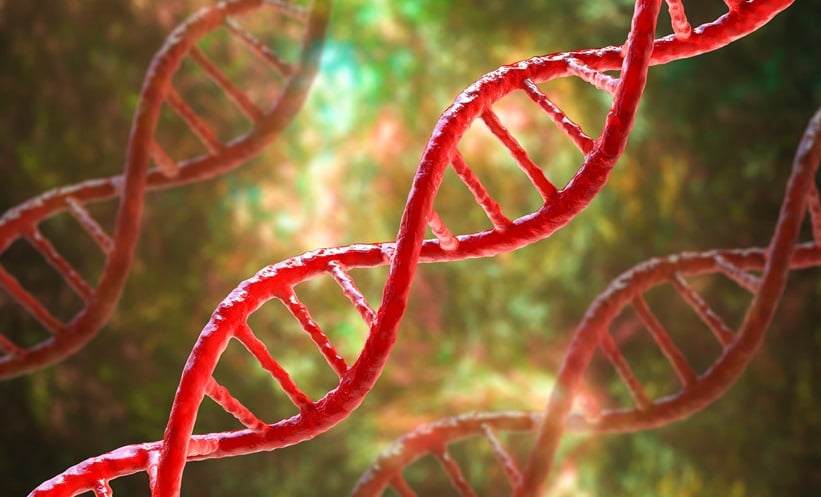The following highlights showcase cutting-edge research presented at the 41ˢᵗ Annual Meeting of the European Society of Human Reproduction and Embryology (ESHRE), held in Paris, France. This selection explores the latest innovations in reproductive medicine, from AI in sperm detection and the role of the endometrial microbiome, to the psychological impact of pregnancy loss and the effectiveness of pre-implantation genetic testing in reducing time to pregnancy. Together, these findings reflect the dynamic progress shaping fertility care today.
Psychological Toll of Pregnancy Loss Evident in Both Women and Men
A LARGE prospective study presented at ESHRE 2025 revealed the significant mental health impact of pregnancy loss on both women and their partners, highlighting an urgent need for improved psychosocial support in reproductive care.1
Led by Astrid Marie Kolte, Copenhagen University Hospitals, Denmark; Hvidovre Hospital, Denmark, the study followed over 2,000 women and 1,200 partners across 4 years, assessing symptoms of depression, stress, and anxiety within 2–8 weeks after pregnancy loss.
Among women, nearly half (49.4%) reported elevated stress, while 24.1% had moderate-to-severe anxiety, and 12.2% met criteria for moderate-to-severe depression. Partners were also affected, with 23.6% reporting stress, 8.3% anxiety, and 3.8% depression.
Key risk factors included prior pregnancy losses and insufficient primary treatment, both strongly associated with worse mental health outcomes. Conversely, having living children was linked to lower rates of distress across all measures.
Being one of the few studies to include both members of the couple, the study offers new insight into the often overlooked psychological toll on partners. The results show that pregnancy loss is not only a clinical event but a deeply emotional one, with lasting implications for both individuals. Future care models should incorporate tailored psychological support as part of comprehensive miscarriage management.
AI Tool Outperforms Age Stratification in Predicting IVF Pregnancy Success
A NEW machine learning model can more accurately predict the likelihood of pregnancy before IVF begins, outperforming conventional age-based methods and promising more personalised counselling for patients, according to research presented at ESHRE 2025.2
Maternal age has long been the dominant factor in assessing IVF success, but researchers argue that relying solely on age can overlook other critical influences, like ovarian reserve, sperm quality, and past IVF outcomes. This new approach uses AI to integrate these additional variables, offering couples a clearer understanding of their chances of conception.
The international, multicentre study analysed 3,852 first autologous IVF cycles performed between 2018–2023, across six fertility centres in two countries. Cases involving egg donation, fertility preservation, or genetic testing were excluded. The AI model included multiple clinical variables: maternal and paternal age, anti-Müllerian hormone levels, antral follicle count, sperm origin and type, and history of past failed cycles.
Researchers trained three separate machine learning models to predict the likelihood of a positive biochemical pregnancy after the first, second, and third embryo transfers. Each model accounted for the chance that no transfer would occur. They used repeated ten-fold cross-validation to ensure robustness and compared the AI’s performance with traditional age-based prediction models.
The AI model significantly outperformed age-only models in predicting biochemical pregnancy, achieving a higher area under the curve score (0.731 versus 0.695) and improved accuracy (67.5% versus 65.3%). Importantly, the model was most accurate at the extremes: it correctly predicted outcomes with over 86% accuracy for women with a <20% chance of pregnancy, and nearly 78% accuracy for those with a >80% chance. Predictive accuracy was lower in mid-range probability cases, between 40–59%.
Explainability analyses confirmed maternal age as the top predictor in first transfers, but for subsequent transfers, ovarian reserve markers, such as anti-Müllerian hormone levels and antral follicle count, became more influential. Previous cycle outcomes also helped refine predictions.
While the AI model is not intended to replace clinical decision-making, it offers a meaningful step forward in IVF counselling. By providing patients with more accurate and individualised expectations from the outset, it may help reduce anxiety and improve the quality of shared decision-making.
Gaps in Miscarriage Data and Reporting in France
A NEW French study presented by Marie-Caroline Compans, Sexual and Reproductive Health and Rights Unit, Institut national d’études démographiques (Ined), Aubervilliers, France, at ESHRE 2025, sheds light on the challenges of accurately measuring miscarriage prevalence and risk factors using diverse data sources.3 Drawing on 13,632,246 medical records for pregnancies, FECOND study survey data (2010–11), a nationally representative sample of women of reproductive age in France (N=7,196 pregnancies), and 50 in-depth interviews about miscarriage experiences, the research emphasises the need for a multi-source approach to understand early pregnancy loss in France.
Findings show a decline in hospital-managed miscarriages, from 6.9% of clinically recognised pregnancies in 2009 to 5.1% in 2023, based on the French National Health Data System. Including primary care data, these rates range from 9.9% in 2013 to 8.9% in 2023, still lower than the 14.0% miscarriage rate reported in the FECOND national survey. This discrepancy suggests that many miscarriages go unreported in medical records, particularly those managed outside of hospitals.
Both sources confirmed maternal age and previous miscarriages as major risk factors, but neither showed strong links between miscarriage and socio-economic status. Contrary to expectations, financial precarity and educational attainment were not significantly associated with miscarriage risk.
The study’s upcoming qualitative interviews aim to uncover why miscarriages are misreported or underreported in surveys. Researchers hope to better understand how women interpret and respond to questions about pregnancy loss, which could help improve future data collection.
The findings could inform more accurate reproductive health monitoring and help address existing data limitations in both medical and survey-based systems.
Failed First Frozen Embryo Transfer Does Not Predict Second Failure
A RECENT retrospective cohort study, presented at ESHRE 2025, offers reassurance to women undergoing fertility treatment, showing that a prior failed frozen embryo transfer (FET), whether due to biochemical pregnancy loss (BPL), clinical pregnancy loss (CPL), or implantation failure (IF), does not increase the risk of another pregnancy loss in a subsequent FET.4
The study examined outcomes of 2,385 women who underwent their first two single embryo FETs using either untested or genetically screened (euploid) embryos between 2017–2021 at a high-volume fertility centre.
Among women whose first FET resulted in BPL, CPL, or IF, second FET outcomes were statistically similar across all groups. Rates of subsequent BPL, CPL, and IF in the second FET were comparable, regardless of the outcome of the first transfer. Live birth rates in the second FET also showed no significant difference across groups, with results remaining consistent even after accounting for factors such as age, embryo quality, BMI, endometrial thickness, and hormonal levels.
Importantly, in both euploid and untested embryo transfers, prior loss or implantation failure did not negatively affect future FET success. These results challenge concerns that an initial failed cycle may signal an underlying reproductive issue that is likely to recur.
While the study is limited by its retrospective design, its findings provide valuable insights for clinicians and patients. In an emotionally and financially demanding treatment journey like IVF, this evidence supports a more optimistic outlook for those experiencing early setbacks. Patients can be reassured that a prior failed FET does not predict poor outcomes in a future transfer, offering renewed hope and a clearer path forward in fertility planning.
Study Compares Fertility Journey for 2S/LGBTQIA+ and Mixed-Gender Couples
NEW research presented at ESHRE 2025 has demonstrated that Two-Spirit (2S)/LGBTQIA+ couples undergoing medically assisted reproduction (MAR) report higher relationship satisfaction and lower depressive symptoms than mixed-sex/gender couples, but encounter significant systemic and interpersonal barriers within fertility care.5
Previous research has shown that 20% of MAR-seeking couples identify as 2S/LGBTQIA+, yet fertility care remains rooted in a medicalised, cisgender framework of infertility, and little is known about the psychological and relational impact on 2S/LGBTQIA+ couples. Although some research has begun exploring the well-being of lesbian couples in this context, broader evidence for other gender and sexual minority populations has been scarce, especially regarding patient-centred care and relational dynamics.
This mixed-methods study forms part of a wider longitudinal project examining the experiences of 345 couples (80 2S/LGBTQIA+ and 265 mixed-sex/gender), recruited from Canada and the USA between November 2019–April 2024. The 2S/LGBTQIA+ sample comprised couples with same-gender partners and those with gender-diverse identities. The authors noted that the sample lacked racial and educational diversity, and that male same-sex/gender couples were underrepresented.
Couples about to begin MAR completed validated questionnaires on sociodemographics, medical history, psychological and relationship functioning, and perceptions of patient-centred care. Additionally, 2S/LGBTQIA+ participants provided qualitative data via an open-ended question about clinic experiences.
Quantitative results revealed no significant differences in anxiety symptoms or patient-centred care communication and respect domains between groups. However, mixed-sex/gender couples had higher depressive symptoms (F[1, 205.347]=7.123; p=0.008; d=0.34), whereas 2S/LGBTQIA+ couples reported greater relationship satisfaction (F[1, 212.442]=8.288; p=0.004; d=–0.39) and more frequent use of dyadic coping strategies (F[1, 206.457]=5.929; p=0.016; d=–0.35).
Qualitative feedback from the 2S/LGBTQIA+ cohort revealed frequent barriers such as heteronormativity, financial strain, and repeated identity disclosures, as well as microaggressions from healthcare providers and families, contributing to additional stress. Nevertheless, strong relational bonds and robust social support networks emerged as important coping resources.
The findings indicate that, although 2S/LGBTQIA+ couples are resilient and maintain healthy relationships amid systemic challenges, mainstream fertility services often fail to address their unique needs. For clinical practice, these results underscore the importance of inclusive, affirming care: providers should address the broader spectrum of family structures and adapt communication, mental health support, and clinic systems to avoid perpetuating stigma. Continuous education on diversity, policy changes to improve access, and tailored support for minority stressors are essential for creating equitable reproductive care for all family formations.
AI Tool ‘T’easy’ Boosts Speed and Accuracy in Sperm Detection
PRESENTED at ESHRE 2025, a novel AI-driven platform known as T’easy is redefining how embryologists identify sperm in testicular tissue samples. The technology, developed by researchers at UZ Brussel, Belgium, in collaboration with Robovision AI, Ghent, Belgium, offers a faster, smarter, and more precise approach to sperm detection following testicular sperm extraction, a complex but crucial procedure in male infertility treatment.6
In cases where ejaculation is not possible or effective, sperm must be retrieved directly from testicular tissue. However, identifying viable sperm within dense, immotile cell suspensions is time-consuming and demands highly trained staff. T’easy addresses this challenge by combining AI algorithms, high-resolution imaging, and operator validation to automate the detection process.
The system was trained on 5,373 annotated images and over 13,000 labelled spermatozoa, with performance tested across multiple datasets. In the initial test set, T’easy achieved a recall of 95.0% and a precision of 94.8%. While performance slightly decreased with a larger, more diverse dataset (89.1% recall; 80.7% precision), further model training led to strong proof-of-concept results. In two clinical samples, T’easy identified over 98% of sperm cells, with fewer false positives and negatives than human operators, in less than half the time.
Each sample analysis took only 10 minutes using T’easy, compared to 24 minutes by experienced embryologists, who also detected fewer sperm overall.
While further refinements are needed to improve generalisability and image consistency, T’easy represents a major step toward automation in fertility labs, with the potential to streamline testicular sperm extraction workflows, reduce operator fatigue, and enhance outcomes in assisted reproduction.
Species-Specific Role of Lactobacilli in Endometrial Health
NEW data from a large-scale retrospective study presented at ESHRE 2025 suggests that not all Lactobacillus species offer equal protection against pathogenic bacteria in the endometrium, a finding that may help refine future diagnostics and therapeutic approaches to infertility.7
Researchers from Igenomix Vitrolife Group, Valencia, Spain, shared results from an analysis of 7,795 endometrial biopsies, investigating the presence of Lactobacillus species and their relationship to 26 potential reproductive tract pathogens.
While Lactobacillus crispatus was associated with lower pathogen prevalence (11.9%), Lactobacillus gasseri showed the opposite trend, with nearly half (45.8%) of samples testing positive for at least one pathogen. Samples containing Lactobacillus iners and Lactobacillus jensenii had intermediate pathogen rates of 28.7% and 24.2%, respectively.
The study also found that the absence of any Lactobacillus species was correlated with higher rates of pathogen detection (31.1%) compared to samples with Lactobacillus present (23.3%; p<0.001). In multivariate analysis, Lactobacillus gasseri was positively associated with pathogen presence (adjusted odds ratio: 2.3), while Lactobacillus crispatus showed a protective association (adjusted odds ratio: 0.5).
Though limited by its retrospective nature and lack of direct clinical outcome data, the study underscores the clinical value of microbiome profiling in reproductive medicine and suggests that Lactobacillus species should not be treated as a single, uniform category in future diagnostics and interventions.
Pre-implantation Genetic Testing for Aneuploidy Reduces Time to Pregnancy in Women Aged ≥39 Without Affecting Per-Cycle Success Rates
A MULTICENTRE retrospective study presented at ESHRE 2025 suggests that preimplantation genetic testing for aneuploidy (PGT-A) significantly shortens the time to live birth in women aged ≥39, without compromising cumulative live birth rates per started IVF cycle.8
The study, conducted across a multinational private fertility network, analysed 4,763 patients aged ≥35 years undergoing their first IVF/intracytoplasmic sperm injection cycle. Propensity score matching was used to compare 1,440 patients who underwent PGT-A with 1,440 who did not, adjusting for key variables such as age, oocyte yield, and treatment year.
While both groups showed similar rates of available blastocysts and comparable cumulative live birth rates (30.1% with PGT-A versus 32.4% without), the live birth rate per embryo transfer was significantly higher in the PGT-A group (44.2% versus 29.1%; adjusted odds ratio: 2.15; 95% CI: 1.78–2.61).
Importantly, PGT-A conferred a significant advantage in time to pregnancy, but only among women aged ≥39. In this subgroup, time to live birth was notably shorter (adjusted hazard ratio: 2.53; 95% CI: 1.56–4.12), a trend that remained significant even in women aged ≥40 and ≥41 years.
Although retrospective in design and limited to first-cycle analysis, the study provides valuable real-world evidence that PGT-A may enhance treatment efficiency and patient satisfaction for selected age groups, without sacrificing per-cycle outcomes.







